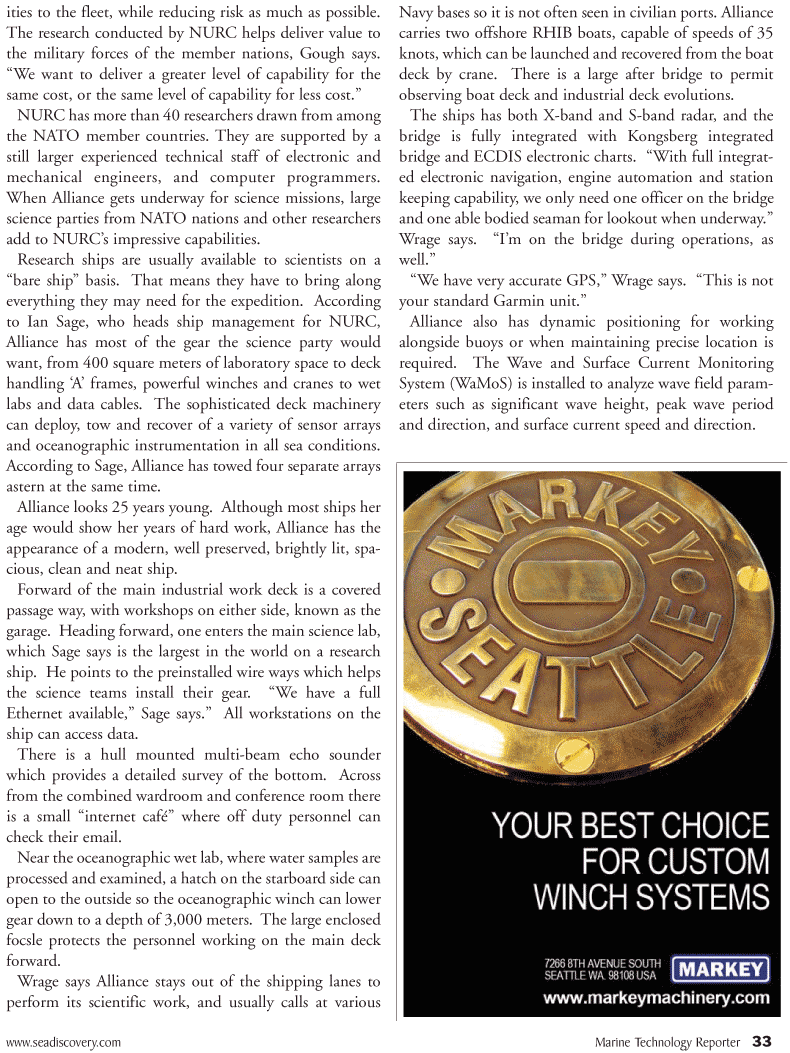
Page 33: of Marine Technology Magazine (April 2012)
Global Offshore Deepwater Report
Read this page in Pdf, Flash or Html5 edition of April 2012 Marine Technology Magazine
www.seadiscovery.com Marine Technology Reporter 33ities to the fleet, while reducing risk as much as possible. The research conducted by NURC helps deliver value to the military forces of the member nations, Gough says. We want to deliver a greater level of capability for the same cost, or the same level of capability for less cost.? NURC has more than 40 researchers drawn from among the NATO member countries. They are supported by a still larger experienced technical staff of electronic and mechanical engineers, and computer programmers. When Alliance gets underway for science missions, large science parties from NATO nations and other researchers add to NURCs impressive capabilities. Research ships are usually available to scientists on a bare ship? basis. That means they have to bring along everything they may need for the expedition. According to Ian Sage, who heads ship management for NURC, Alliance has most of the gear the science party would want, from 400 square meters of laboratory space to deck handling A frames, powerful winches and cranes to wet labs and data cables. The sophisticated deck machinery can deploy, tow and recover of a variety of sensor arrays and oceanographic instrumentation in all sea conditions. According to Sage, Alliance has towed four separate arrays astern at the same time.Alliance looks 25 years young. Although most ships her age would show her years of hard work, Alliance has the appearance of a modern, well preserved, brightly lit, spa- cious, clean and neat ship. Forward of the main industrial work deck is a covered passage way, with workshops on either side, known as the garage. Heading forward, one enters the main science lab, which Sage says is the largest in the world on a research ship. He points to the preinstalled wire ways which helps the science teams install their gear. We have a full Ethernet available,? Sage says.? All workstations on the ship can access data.There is a hull mounted multi-beam echo sounder which provides a detailed survey of the bottom. Across from the combined wardroom and conference room there is a small internet café? where off duty personnel can check their email.Near the oceanographic wet lab, where water samples are processed and examined, a hatch on the starboard side can open to the outside so the oceanographic winch can lower gear down to a depth of 3,000 meters. The large enclosed focsle protects the personnel working on the main deck forward. Wrage says Alliance stays out of the shipping lanes to perform its scientific work, and usually calls at various Navy bases so it is not often seen in civilian ports. Alliance carries two offshore RHIB boats, capable of speeds of 35 knots, which can be launched and recovered from the boat deck by crane. There is a large after bridge to permit observing boat deck and industrial deck evolutions. The ships has both X-band and S-band radar, and the bridge is fully integrated with Kongsberg integrated bridge and ECDIS electronic charts. With full integrat- ed electronic navigation, engine automation and station keeping capability, we only need one officer on the bridge and one able bodied seaman for lookout when underway.? Wrage says. Im on the bridge during operations, as well.? We have very accurate GPS,? Wrage says. This is not your standard Garmin unit.? Alliance also has dynamic positioning for working alongside buoys or when maintaining precise location is required. The Wave and Surface Current Monitoring System (WaMoS) is installed to analyze wave field param- eters such as significant wave height, peak wave period and direction, and surface current speed and direction.

 32
32

 34
34
